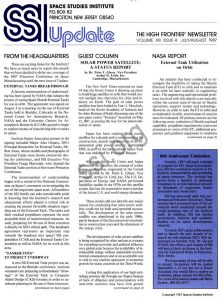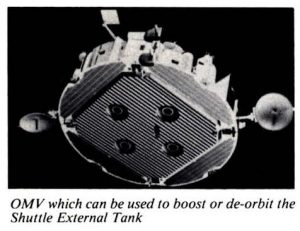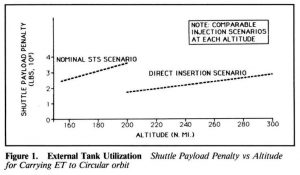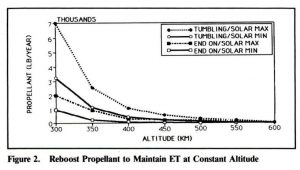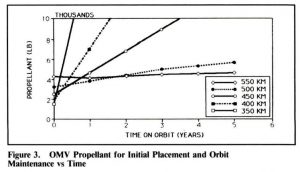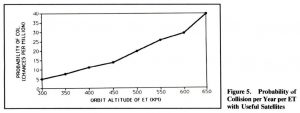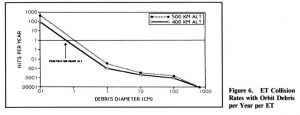SPACE STUDIES INSTITUTE
P.O. BOX 82
PRINCETON, NEW JERSEY 08540
[[librarian note: This address is here, as it was in the original printed newsletter, for historical reasons. It is no longer the physical address of SSI. For contributions, please see this page]]
SSI UPDATE
THE HIGH FRONTIER® NEWSLETTER
VOLUME XIII ISSUE 4
JULY/AUGUST 1987
FROM THE HEADQUARTERS
These are exciting times for the Institute! We have so much news to report this month that we have decided to defer our coverage of the 1987 Princeton Conference on Space Manufacturing until the next issue of Update.
EXTERNAL TANKS BREAKTHROUGH
A historic memorandum of understanding has been signed by NASA that initiates the process of saving Space Shuttle External Tanks for use in orbit. The agreement was signed on August 3 at a meeting on the use of External Tanks held in Boulder, Colorado at the National Center for Atmospheric Research. NASA and the University Centers for Atmospheric Research (UCAR) agreed to begin to explore means of transferring title to tanks in space.
Institute Senior Associates present at the signing included Major Alex Gimarc, SSI’s Principal Researcher for External Tanks, Mr. Ron Jones, whose models and photographs of External Tanks were shown extensively during the conference, and SSI Executive Vice President Gregg Maryniak, who chaired the External Tanks portion of the recent Princeton Conference.
The memorandum of understanding begins with a recital of the National Commission on Space’s comments on investigating the use of this important space asset. All members of the SSI family can take considerable pride in knowing that the Institute’s research and educational efforts played a critical role in creating the present favorable situation regarding use of the External Tank. The tanks and their residual propellants represent the most accessible form of nonterrestrial resources. As such, preparing for the use of these resources is directly on SSI’s critical path. This landmark agreement represents an important step towards the breakout into space! SSI congratulates UCAR and the External Tanks Corporation as well as NASA for its work in this area.
“TANKER-TOYS” ET PROJECT UNDERWAY
A new SSI External Tank project was announced at the Boulder conference. Institute volunteers are preparing to disseminate “drawings” of the External Tank in Computer Aided Design (CAD) formats in order to accelerate planning in the use of these resources.
The project was created by SSI staff member Rick Tumlinson and dubbed “Tanker-Toys.” Work is proceeding under the direction of Bill Engfer and with the assistance of David Ways. The initial CAD program that will be serviced is AUTOCAD™, a product of the AUTODESK corporation and a leader in CAD programs for personal computers. Eventually, other versions may be supported if warranted by demand. Additional information will be available on the Institute’s Computer Bulletin Board. (See below)
As the result of National Commission on Space and Congressional interest in External Tanks, NASA was directed to report on the feasibility of saving and using these tanks. This report is presented in this issue of Update.
SSI TO CONDUCT NEW LUNAR SYSTEMS STUDY
This January, the Space Studies Institute will conduct a major systems study on the use of lunar resources. Institute supporters know that our goal is to demonstrate the steps necessary to achieve the human breakout into space. Through our research and technology demonstrations we are proving out each of the elements of the critical-path needed to attain this goal. Systems studies are the overall blueprints for this activity. They define the critical path and help us to focus on those areas remaining to be developed.
Dr. O’Neill and the Institute have participated in several key systems studies in the past. The initial large studies which defined the direction of our efforts were the original NASA Summer Studies on space colonization which took place in the mid 1970’s and preceded the founding of SSI. These efforts described the use of lunar mining, mass-drivers, chemical processing and space colonies.
In 1978, Dr. O’Neill’s article The Low (Profile) Road to Space Manufacturing was published by the AIAA. This systems study suggested that by using External Tank material as reaction mass, the space colonization work described in the earlier studies could be substantially accelerated. (Of historical interest is the fact that this article contained some of the first descriptions of SSI and its work.)
SSI’s next major systems study was entitled New Routes to Manufacturing in Space. Released in October, 1980, this study examined new key techniques for downsizing the initial investment required to begin using space resources. The concepts of “scaling” and “bootstrapping” were introduced.
Editor’s note: the report of this systems study is available in two forms. It can be downloaded from the Institute bulletin board or a hard copy can be obtained for $2.00 by writing SSI.
Since the 1980 New Routes study, SSI has completed several major research goals. Massdriver acceleration has nearly doubled since 1980. The HF acid leach technique for processing lunar soil into constituent elements has been demonstrated by bench chemistry. SSI has completed a design for the construction of Solar Power Satellites from over 99% lunar materials. Ongoing work on glass/glass composites indicates substantial benefits to construction of structures. External Tank projects indicate that the tanks and their residual propellants will play a critical role in space development.
Therefore, our January study will take a fresh look at the use of space resources with the benefit of all of our research (and indeed everyone’s research) since 1980. The goal will be to map out all of the steps from a human return to the Moon to the construction of Solar Power Satellites from lunar material. Each available product along the way will be identified.
To date, SSI has received indications of support for this work from Boeing, General Electric, Arthur D. Little, RCA Astro and Martin Marietta in addition to the members of SSI. We need your help to undertake this important project. Please support this work today!
SPACE RESOURCES COMPUTER MODEL
A related new SSI project is the creation of a comprehensive computer model of the economics of space resource utilization. Leading this project is Dr. Andrew Cutler of California Space Institute. Dr. Cutler’s project will tie in with SSI’s systems studies and provide a useful and long overdue tool for evaluating space systems. Stay tuned for more details in future issues of Update.
NASA DEVELOPMENTS
A number of interesting projects and reports have come out of the space agency this summer. First and foremost is Astronaut Sally Ride’s report to Dr. James Fletcher entitled Space 1995. Present indications are that it will suggest manned missions to the Moon by the year 2000 as the agency’s next major goal after Space Station. The agency has created a new Office of Exploration “to analyze and define missions proposed to ACHIEVE THE GOAL OF HUMAN EXPANSION OFF THE PLANET.” Dr. Ride, who will retire from NASA in September is serving as interim head of this office.
NASA is also planning important new technology development initiatives to develop the tools required to implement the National Commission on Space recommendations. These initiatives have names such as Civil Space Technology Initiative, Pathfinder and University Space Engineering Centers. SSI is closely following these developments. On August 18th we will brief the Director and staff of the Office of Space on the work and plans of the Institute and how we may assist these new NASA initiatives.
Both NASA and the DOD are actively pursuing development of Heavy Lift Launch Vehicles. NASA is looking particularly at Shuttle derived systems with DOD interest appearing to be centered on a completely new launch system generically described as an Advanced Launch System or ALS.
SOVIETS ANNOUNCE SOLAR POWER SATELLITE PLANS
In mid-May, the Soviet Union launched its first Energia Heavy-Lift Launch Vehicle. According to reports, it is capable of placing about 150,000 pounds into low Earth orbit. Recent reports indicate that its strap-on liquid fuel boosters are fully recoverable. On June 14, a front-page story in the New York Times reported that the Soviet Union intends to use this capability to construct one or more Solar Power Satellites in Earth orbit. Although Soviet press releases have indicated intense interest in SPS for several years, the New York Times article reflects the first major Western coverage of these intentions. The Institute’s work on Solar Power Satellites from lunar material was later the subject of a United Press International wire service release. This issue of Update features a brief report on SPS by Dr. Peter Glaser, the inventor of the SPS concept.
SSI TO COSPONSOR NASA LUNAR BASE CONFERENCE
SSI researchers are invited to submit abstracts for NASA’s Lunar Bases and Space Activities of the 21st Century Symposium. This meeting will be held on April 5-7 in Houston and will be cosponsored by NASA, the Lunar and Planetary Institute, Space Studies Institute and AIAA. Copies of the abstract form are available from:
Stephanie Tindell
Lunar and Planetary Institute
3303 NASA Road I
Houston, Texas 77058
(xxx) xxx-xxxx
Please act quickly in order to participate in this conference. With all of the growing interest in the use of lunar resources, this should prove to be an important event.
SSI BULLETIN BOARD
With all of the late breaking news, SSI has instituted a new tool to keep in touch with our supporters and volunteers. Our computer bulletin board operates during non-business hours during the week and on Saturdays and Sundays. It is still somewhat experimental, but with the help of a number of hard-working volunteers the board is beginning to become an important information resource. All it takes is a computer and a 300 to 1200 baud modem. The number is xxx-xxx-xxxx. Sign on and give it a try!
CONCLUSION
SSI is facing a critical yet rewarding time. We can give ourselves a well-deserved pat on the back for our role in such things as the External Tanks developments and the National Commission on Space report results. However, we face new challenges such as those posed by foreign SPS developments and our U.S. colleagues who argue in favor of “flags and footprints” one-shot space goals. As the Institute approaches its 10th anniversary We urge you to increase your participation in our vital work.
Editor’s note: In June of 1986 SSI’s research on the design of a solar power satellite from lunar material was presented at an international conference in Paris, France cosponsored, in part, by the French National Power Industry. As this article by Dr. Peter Glaser indicates, international interest in SPS is growing stronger than ever. (For a copy of the final report of the SSI study on the design of a Solar Power Satellite from lunar material send $10.00 to the Institute.)
GUEST COLUMN
SOLAR POWER SATELLITE: A STATUS REPORT
by Dr. Peter E. Glaser, Vice President
Arthur D. Little, Inc.
Cambridge, Massachusetts
The New York Times reported on June 14 that the Soviet Union is drawing up plans to build huge satellites in orbit that would convert sunlight into electricity for cities and industry on Earth. The goal of solar power satellites has been hailed by Guri J. Marchuk, head of the Soviet Academy of Sciences and by other Russian officials discussing uses of the new giant rocket “Energia” launched on May 15, 1987, as paving the way for the industrialization of space.
Japan has been studying solar power satellites for a decade and is recommending the construction, launch and operation of an experimental solar power satellite, starting in 1992, as part of the International Space Year that was endorsed by President Reagan.
Although the Soviet Union and Japan have seized the initiative, the concept of a solar power satellite was originated in the United States in 1968 by Dr. Peter E. Glaser, Vice President, Arthur D. Little, Inc. The U.S. Department of Energy and NASA performed feasibility studies in the 1970s on this satellite system that has the potential to meet a portion of the future U.S. and world energy demands.
These studies did not identify any major reason for concluding that solar power satellites could not be built and operated successfully. The development of the solar power satellite was abandoned in the early 1980s, partly because of the then perceived uncertainties in construction costs and the abatement of the energy crisis.
The development of solar power satellites is being recognized by other nations as a means for extending economic and political influence on a global scale because the availability of inexhaustible energy without undesirable environmental consequences and at an acceptable cost is vital to any realistic approach to economic growth for many countries of the Third World.
Letting this application of our high technology prowess slip through our fingers because of lack of diligence and preoccupation with near-term concerns may have even greater adverse effects on the U.S. economy than the dislocations suffered by such major industry sectors as consumer goods, and automobiles. It is time to evaluate the potential losses by foreclosing the opportunities presented by solar power satellites to maintain U.S. leadership in space and to take the necessary actions to ensure that the U.S. will have a significant role in the evolving industrial activities in space.
SSI Media Presentations
Two new media presentations have been added to the media resources available from SSI.
The Vision
A one hour audio cassette in which Dr. O’Neill, SSI’s founder, explains the SSI vision of a hopeful future. Dr. O’Neill traces the history of space colonies and solar power satellites and the reasons we will use nonterrestrial resources to build them. This historical tape is an ideal tool for loaning to friends who what to know more about space development. $ 9.95
Living in Space: Space Stations and Colonies
The first of a series of annotated presentations, this 20 slide set traces humanity’s quest to establish permanent dwellings in space. It covers space habitation from Salyut through the NASA space station and on to Island Three, a colony that may house over a million people. The slides are accompanied by a script and notes to guide the presenter through an interesting and informative presentation.$ 19.95
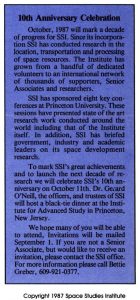
NASA REPORT
External Tank Utilization on Orbit
An analysis has been conducted to investigate the feasibility of taking the Shuttle External Tank (ET) to orbit and to maintain it on orbit for later scientific or engineering tasks. The engineering and operational problems involved with this objective are basically within the current state-of-the-art of Shuttle operations, support system and technology. However, in order to take the ET to orbit and to maintain it in orbit, several areas of concern must be evaluated. Of primary interest are the following areas: reduction of Shuttle payload capability, propellant requirements to prevent premature re-entry of the ET, additional propulsion and guidance equipment to maintain the ET oriented in orbit, accessibility of orbiting ET, probability of micrometeoroid or space debris damage to the ET or potential impact of the ET with useful satellites, cost of ET modifications and operational costs, etc.
Analysis of these and other areas provides an overview of the requirements associated with the utilization of the ET.
To evaluate the additional propellant needed to take the ET to orbit, one should first be acquainted with the two customary Shuttle ascent profiles. One is called the “Nominal STS Mission” and the other is known as the “Direct Orbit Insertion Mission.”
In the Nominal STS Mission, the Shuttle main engines burn until a specific set of “main engine cut off” target conditions is reached. The ET is separated. The Shuttle orbital maneuvering system (OMS) then provides the additional velocity needed to place the Orbiter into a transfer orbit with the apogee equal to the desired orbit. The second OMS maneuver occurs at apogee and places the Orbiter into its final orbit. In the Nominal STS Mission, the ET then impacts in the Indian Ocean or the Southern Pacific Ocean depending on launch from the Eastern Test Range (ETR) or Western Test Range (WTR) respectively. To take the ET to orbit in this mission, a payload penalty results. The penalty is approximately 3000 lbs. depending on the circular orbit altitude to which the ET is taken. This payload penalty is additive to the reduction of Shuttle payload weight which always occurs with increasing altitude.
The Direct Orbit Insertion Mission eliminates the OMS 1 burn by continuously burning the main engines to a set of cut-off conditions which will provide the proper apogee. In this scenario, the ET impacts in the Southern Pacific Ocean or the Northern Pacific Ocean for either ETR or WTR launches respectively.
Taking the ET to orbit in this scenario results in a payload penalty of approximately 2200 lbs. for altitudes ranging from 200 to 300 n.m. At altitudes below this range, orbital lifetime without reboosting is limited to a few days. For instance, decay and re-entry from 300 km (160 n.m.) would occur within 30 to 35 days for atmospheric density conditions during 1988 and “broad side” drag orientation, unless reboosting of the ET can be accomplished. Since the atmospheric density is a strong function of altitude and solar cycle activity, and since the drag forces acting on the ET vary extensively with the ET orientation, a comparison of these parameters must be made to determine the reboost propellant requirements. The yearly propellant requirements periodically reboost the ET, i.e. maintaining the initial “storage” altitude. The propellant requirements are parameterized with respect to solar cycle activity and drag orientation of the ET.
Since the ET cannot be maintained at low orbital altitudes for any significant time without large propellant consumption, it is necessary to place the ET at an orbital altitude which is relatively drag free. As can be seen from Figure 2 at altitudes above 500 km (270 n.m.), the propellant requirement for reboosting the tank is negligible for nominal atmospheric conditions and nominal solar activity.
An alternative is to place the ET initially at a sufficient altitude to conserve reboost propellant utilizing the Orbital Maneuvering Vehicle (OMV) for transfer of the ET to an initial altitude above the 160 n.m. Shuttle insertion altitude. Boosting the ET to higher altitude via an OMV results in the lowest overall propellant requirement for lifetimes over three years. If it is desired to use the tank within a few months from the launch date, a combination of boosting (to an intermediate altitude) and altitude maintenance results in the lowest propellant consumption.
For altitudes less than 500 km (270 n.m.), a guidance system is required for attitude control and reboost guidance. This control can be provided by either an OMV or an ET onboard system. The weight and power requirements for this system are estimated to be 2500 lbs. and 125 watts respectively. A small (6.8 sqm) fixed solar array /battery system is included to provide the required power. Above an altitude of 500 km, the air drag is low enough to avoid the need for attitude control of the ET.
Another approach, based on the MartinMichoud scavenging study, would be the use of a customized Orbital Transfer Vehicle (OTV) which would use residual propellants left in the ET after insertion. Sufficient propellant remains in the ET to boost the ET to greater than 500 km (270 n.m.). Such a system would require a substantial new development program however.
Safety considerations would probably demand the incorporation of means for controlled de-orbit of the ET. The ET could be de-orbited by ground control using an OMV. The propellant required by an OMV which is subsequently recovered by the Shuttle would be 5175 lbs. Another option is the use of solid propellant STAR motors which would have been installed prior to launch. De-orbit impulse is provided by four Thiokol STAR 26B (or STAR 27) solid rocket motors (SRM’s). Each SRM provides an average thrust of 7970 lbs. for approximately 18 seconds. A de-orbit system of this type has been defined for another application. This also requires an attitude control system to establish proper attitude for de-orbit and to provide an ET spin rate of 20 degrees per second prior to SRM firing. A baseline hydrazine system provides these capabilities. The total system weight including electrical power and communication system, a hydrazine attitude control system, and the STAR SRM’s is approximately 5411 lbs.
The ET is already equipped with the necessary hardware to dump and vent the residual propellants remaining at MECO. However, a tumble valve which is normally activated by the Orbiter after MECO must be modified to prevent end-over-end tumbling of the ET. In addition, the range safety system must be modified to make the ET safe for later use. Further, to assure venting of the gaseous hydrogen and oxygen from the ET for post MECO safety, a small gaseous helium bottle must be added, and a non-propulsive GH2 vent duct must also be installed. The modifications of the safing system and additional helium pressurization, etc. are estimated to weigh approximately 335 lbs. Safing of the STAR retromotors would be accomplished with a state-of-the-art range safety system similar to the systems used on the solid rocket boosters or the Inertial Upper Stage (IUS). Arming of the system would also have to be accomplished from the Orbiter.
The probability that any of a large number of ET’s (10 to 100) would collide with another useful satellite at any altitude is very low. However, on the average each ET will be penetrated by 1 to 3 impacts per year with micrometeoroids. Furthermore, the tank walls may be penetrated by man-made space debris between 1 and 3 times per year, increasing with orbit altitude. There is negligible probability (less than 0.001 per tank per year) that a micrometeoroid or man-made debris large enough to penetrate the ET wall and then exit from the opposite wall, generating shrapnel, will occur. However, it should be noted that the current model on which these data are based has a fairly wide range of uncertainty, and the protection capability of the ET insulation is largely unknown. In any event, penetration of the ET would limit eventual use as a man-rated pressurizable vessel unless a 10,000 lbs. micrometeoroid bumper is provided.
The rough costs of two options have been analyzed for taking the ETs to higher orbit for “storage” until they can be used. Option I utilizes an OMV, as discussed above, for boost to higher orbit and eventual controlled re-entry. In this option each ET is equipped with a docking probe, a minimal communications capability, and the necessary structural strengthening. The ROM recurring cost estimated for this option in 1990 dollars is $ 15M (including $4.5M use charge for a ground-based OMV to deliver each ET to higher orbit and to return the OMV). In Option II each ET is maintained at the Shuttle delivered altitude, oriented for maximum on-orbit lifetime by an onboard attitude control system. The ROM recurring cost estimate for this option is $30M. The deboost for Option I would be an additional $4.5M for an OMV service charge. The deboost for Option II would be an additional $850K (recurring) for four STAR solid rocket motors.
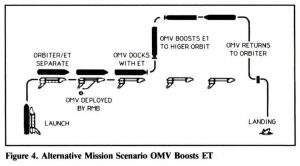
The rough cost per day for the Orbiter to station-keep while scientists are working on the ET is estimated as $700K add-on, if performed in conjunction with a nominal Shuttle mission, based on STS reimbursement guide escalated to 1990 dollars. To rendezvous with an ET previously stored on orbit, its orbital parameters must be matched exactly by the rendezvousing Shuttle vehicle (restricted launch window, launch inclination, unique phasing orbits, etc.). A dedicated STS mission may be required. The mission cost to dedicate an eightday STS mission to modify a standard ET already in a 270 n.m. orbit, using a two-man EVA crew for six days, is in excess of $100M. The actual figure would depend on the type of mission and other factors that cannot be predicted now.
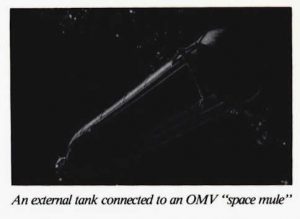
©space studies institute

